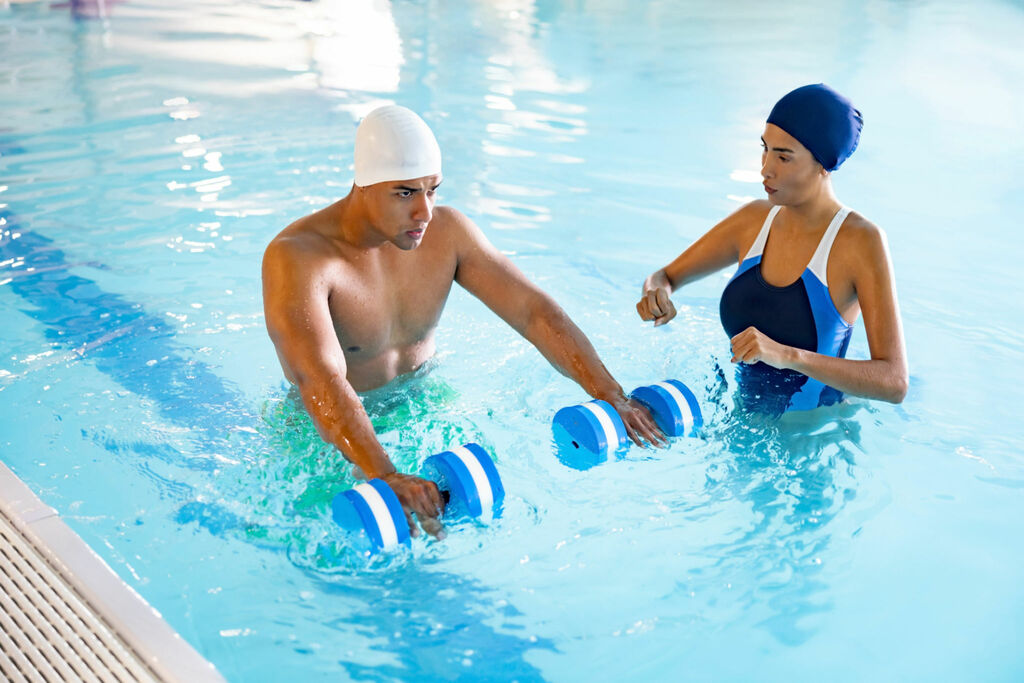
Table of Contents
ToggleIntroduction
Aquatic fitness programs have gained significant popularity in recent years as individuals seek effective and enjoyable ways to maintain their physical and mental well-being. The buoyancy and resistance offered by water create a unique environment for exercise, leading to a myriad of therapeutic benefits. In this article, we will explore the various advantages of engaging in aquatic fitness programs, ranging from physical and muscular benefits to mental health improvements.
Physical Benefits
Low-impact Exercise
Aquatic fitness programs are renowned for their low-impact nature, making them ideal for individuals with joint issues or those recovering from injuries. The buoyancy of water reduces the stress on joints and muscles, providing a gentler alternative to traditional land-based exercises. This characteristic makes aquatic fitness accessible to a broad range of individuals, including superiors and those with conditions like arthritis.
In aquatic environments, the resistance to movement is increased compared to air, yet the impact on the body is minimized. This makes water an excellent medium for individuals looking to improve their cardiovascular fitness without subjecting their bodies to the strain associated with high-impact exercises.
Increased Cardiovascular Fitness
The cardiovascular benefits of aquatic fitness programs are noteworthy. Engaging in activities such as water aerobics or swimming enhances heart health by improving circulation and oxygenation. The hydrostatic pressure exerted by water supports blood flow, reducing the strain on the heart while still providing an effective cardiovascular workout.
Muscular Strength and Endurance
Resistance Training in Water
One of the distinctive features of aquatic fitness is the increased resistance provided by water. The natural buoyancy of the human body in water requires continuous effort to move, engaging muscles in ways that are not possible on land. This resistance aids in the development of muscle tone and strength, making aquatic fitness an excellent choice for those looking to build or maintain muscular health.
In aquatic fitness programs, resistance is not only dependent on the water but can be further enhanced by incorporating aquatic equipment like water dumbbells or resistance bands. These tools add an extra layer of challenge, promoting even greater muscular development.
Whole-body Engagement
Aquatic exercises involve the entire body, requiring the activation of various muscle groups simultaneously. The resistance and buoyancy of water create a comprehensive workout that targets not only major muscle groups but also stabilizing muscles. This holistic approach to exercise contributes to overall strength, flexibility, and coordination.
Rehabilitation and Injury Prevention
Aquatic Therapy
Beyond general fitness, aquatic environments are increasingly recognized for their therapeutic value in rehabilitation. Aquatic therapy involves utilizing the properties of water to aid in the recovery process for individuals dealing with injuries, surgeries, or chronic conditions. The buoyancy of water reduces the impact on joints, allowing for gentle movement and exercise during the healing process.
Aquatic therapy is particularly beneficial for conditions such as arthritis, where movement may be challenging on land. The warmth of the water, coupled with its buoyancy, promotes relaxation and increased flexibility, contributing to a more effective rehabilitation experience.
Injury Prevention
Aquatic fitness programs not only assist in recovery but also play a role in preventing injuries, especially those related to impact on hard surfaces. The reduced stress on joints and muscles during water-based exercises decreases the risk of injuries commonly associated with high-impact activities.
Mental Health Benefits
Stress Reduction
The soothing nature of water has a profound impact on stress reduction. Immersing oneself in water promotes relaxation, and aquatic fitness programs leverage this calming effect to provide a holistic approach to well-being. The rhythmic movements in water, combined with the sound and sensation of water, create a therapeutic environment that contributes to stress relief.
Enhanced Mood
Engaging in physical activity, including aquatic fitness, triggers the release of endorphins, often referred to as “feel-good” hormones. The combination of exercise and the natural elements of water enhances mood and contributes to an overall sense of well-being. This dual benefit of physical and mental well-being makes aquatic fitness a powerful tool for individuals looking to manage stress and improve their mental health.
Accessibility and Inclusivity
Suitable for All Fitness Levels
One of the remarkable aspects of aquatic fitness programs is their adaptability to various fitness levels and abilities. Whether you are a seasoned athlete or someone just starting on their fitness journey, aquatic exercises can be tailored to meet individual needs. The water’s buoyancy provides a supportive environment, making it possible for participants of all fitness levels to engage in a meaningful and effective workout.
In addition to being accessible, aquatic fitness programs are inclusive, welcoming individuals with diverse physical abilities. The adaptability of exercises allows everyone to participate, fostering a sense of accomplishment and community among participants.
Older People and Special Populations
Aquatic fitness holds particular significance for older adults and individuals with specific health conditions. The low-impact nature of water exercises is especially beneficial for the older people, providing a safe and effective way to maintain or improve their physical fitness. The buoyancy of water reduces the risk of falls and injuries, making aquatic fitness a suitable option for superiors looking to stay active.
For individuals with conditions such as arthritis, fibromyalgia, or multiple sclerosis, aquatic fitness offers a therapeutic solution. The supportive and gentle nature of water allows those with limited mobility to engage in exercises that might be challenging on land. Aquatic programs can contribute to improved joint flexibility, pain management, and overall quality of life for individuals dealing with various health challenges.
Social and Community Aspects
Group Fitness Dynamics
Participating in aquatic fitness programs often involves group settings, creating a social dynamic that enhances the overall experience. Group classes, such as water aerobics or aqua Zumba, not only provide a structured workout but also foster a sense of community. The camaraderie among participants can be motivating and supportive, encouraging individuals to stay consistent with their fitness routines.
Building a Sense of Community and Support
The community aspect of extends beyond the class itself. Many individuals find that the shared experience of exercising in water creates bonds that go beyond the pool. The support system developed within these communities can be instrumental in maintaining a regular exercise routine. Whether through encouragement during challenging exercises or shared goals, the sense of community in programs contributes to a positive and motivating environment.
Conclusion
In conclusion, aquatic fitness programs offer a holistic approach to well-being, providing a myriad of therapeutic benefits. From the low-impact nature that eases stress on joints to the mental health advantages of water immersion, these programs cater to diverse needs. Whether for rehabilitation, general fitness, or social interaction, the unique properties of water make aquatic fitness an accessible and inclusive choice for individuals of all ages and abilities. Embrace the buoyancy, resistance, and community spirit to enhance your overall health and quality of life.
FAQs
Q: Who can participate in aquatic fitness programs?
A: These are suitable for individuals of all fitness levels and ages. The adaptability of exercises makes them inclusive for everyone.
Q: What are the benefits of aquatic therapy?
A: Aquatic therapy aids in rehabilitation by providing a low-impact environment, reducing strain on joints. It is beneficial for recovering from injuries, surgeries, and managing conditions like arthritis.
Q: How does aquatic fitness contribute to mental health?
A: The calming effect of water and the release of endorphins during exercise contribute to stress reduction and enhanced mood, positively impacting mental well-being.
Q: Are aquatic fitness programs social activities?
A: Yes, many aquatic fitness classes involve group dynamics, fostering a sense of community and support among participants.
Q: Can older adults and individuals with health conditions participate?
A: Absolutely. Aquatic fitness is particularly beneficial for the older people and those with conditions like arthritis. The low-impact nature of water exercises makes them accessible and therapeutic for various populations.
Q: Can older adults and individuals with health conditions participate?
A: Absolutely. Aquatic fitness is particularly beneficial for the older people and those with conditions like arthritis. The low-impact nature of water exercises makes them accessible and therapeutic for various populations.
